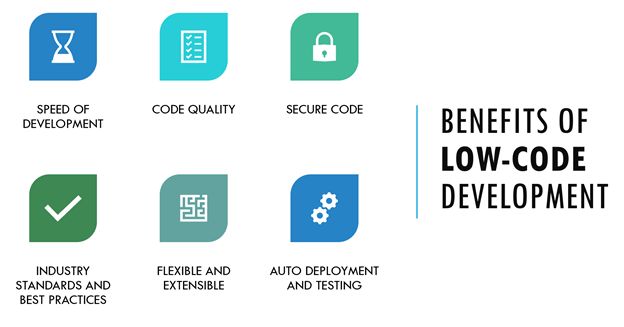Excellent Ideas On Picking Low-Code Platform Examples
Wiki Article
Benefits Of Developing Applications Using Low-Code In Terms Of Accessibility For Non-Developers
Due to a range of important factors, Low-Code Application Development is available to non developers. They are also known as "citizen designers."
Drag-and-Drop Builders : Low-code platforms have drag-and-drop interfaces, which allow people who are not developers, and without the necessity of writing code, to build visually-based applications. This makes it easier for people with no technical expertise to be involved in the development process.
WYSIWYG editor: "What you see is the result you will get" editors let users design interfaces, workflows and other functions in a manner which closely resembles the final outcome. They are easy to comprehend and use.
Simple Workflow and Logic Design:
Visual Workflow Modelling: Users can use visual workflow to create business procedures, application logic, and flowcharts by using diagrams as well as visual flowcharts. These techniques are more intuitive than traditional coding methods.
Pre-built Logic components: Low-code platforms include logic components that have been already built (e.g. conditional loops and statements) and can be configured easily which eliminates the need for complex programming.
Reusable Components & Templates
Libraries of pre-built templates: Numerous low-code platforms have libraries of the most commonly used types of applications, allowing those who are not developers a base that they can build upon and alter.
Reusable widgets and modules The process of creating web pages is made simpler by using reusable components as well as modules. This reduces the necessity for a deep technical understanding.
Guided Development Tutorials and Guided Development:
Step-by-Step Instructions: Platforms typically provide guided development paths, tutorials, and on-screen tips to assist non-developers in developing applications.
Interactive Tutorials Interactive tutorials are interactive and hands-on and help users learn by doing. This improves the confidence of users in the platform.
Integration with an existing tool:
Seamless Integrate: Low code platforms are designed to seamlessly integrate with the existing systems and tools within business (e.g. the CRM or ERP), which lets non-developers to develop applications to work within current workflows.
APIs and Connectors : APIs built-in and connectors allow non-developers and users to easily connect applications with external services without the need for complicated coding.
Collaboration Features:
Team Collaboration: Features like real-time collaboration, as well as shared workspaces allow non-developers to work alongside professionals, business analysts and other stakeholders efficiently.
Access Control Based on Roles: Non-developers can be assigned roles and access levels that allow them to contribute without compromising security or functionality.
Automated Testing and Debugging:
Test tools are included: A lot of low-code platforms come with built-in testing and debugging tools. These tools automate the procedure, making it simple for non-developers ensure that their applications are working correctly.
Error Highlighting Whenever errors are detected, the platform highlights these and suggests possible fixes. It helps non-developers in solving the issue.
Development using low-code is more accessible to non-developers as it makes development more accessible to everyone. Low-code applications allow business users to participate actively in the creation and development of applications by providing intuitive visual tools and guided experience. This is a bridge between technical implementation and business requirements. Have a look at the top look at this on Low-code Platform for application development for website advice including app development platform, cloud software applications, develop web app, build with docker, multiplatform mobile app development, app platforms, app platforms, app development platform, lowcode no code, rapid application design and more.

The Benefits Of Low-Code Development In Terms Of Flexibility, Scalability And Scalability
Low-code applications offer several advantages when it comes to scaleability. They are scalable and flexible, and they can be adjusted to accommodate new needs. These are the most significant advantages:
Cloud-Based Platforms: A lot of platforms for low-code are cloud-based. They permit applications to grow quickly and smoothly using the cloud infrastructure. Businesses can handle more load without having to worry much about the administration of servers.
Auto-Scaling Features - Built-in automatic scaling features automatically adjust resources according to the demand. This provides constant performance during peak times, without the need for manual intervention.
Flexible Architecture:
Modular Design: Low-code platforms encourage modular application design, where components can be independently developed test, scaled, and then redesigned. Modularity improves flexibility and it is easier to update specific parts of an app without having to alter the whole system.
Microservices Architecture: The Microservices architecture enables the development of applications by creating a loosely coupled set of services. This increases both scalability & flexibility.
Customizable Solution:
Extensibility. Low-code platforms typically allow for scripting or programming that is custom. This allows developers to extend the application's functionality beyond what it comes with in the standard package. This allows for unique business needs to be met without limitations.
Third-Party Integrations: The incorporation of APIs, third-party services or other services enables companies to expand the capabilities of their application by incorporating additional functions.
Agile Development and Deployment
Continuous Delivery and Deployment Low-code platform support agile methodologies that allow continuous integration and continuous delivery (CI/CD). This enables rapid delivery of updates and new features, allowing applications to evolve quickly as a result of customer feedback and changes to the market.
Iterative Design: Because low-code is an iterative procedure it is possible to incrementally enhanced and scaled up. This permits controlled growth and reduces the risks of large-scale changes.
Resource Optimization
Efficient resource management Low-code platforms maximize resources by offering tools for monitoring and controlling the performance of the application. This ensures that resources are used effectively and efficiently can be scaled up or down depending on actual requirements.
Load balancer: The app handles high volumes of traffic with ease and consistency due to the load-balancing capabilities.
Global Reach
Multi-Region Availability: Lowcode platforms allow to be used across a variety of regions. Businesses can offer users high-speed, low-latency global access. This is particularly important when applications have an international user base.
Localization: Support for localization is built in, which allows for applications to be easily adjusted for various languages or regional needs. This increases flexibility for diverse markets.
Updates and maintenance:
Low-code software is visually appealing and modularly designed, making it easier to perform maintenance. Updates or bug fixes can be completed quickly and without lengthy downtime.
Version Control Version Control: Integrated version control systems help manage changes and rollbacks making sure that updates are deployed without risk and that previous versions can be restored if required.
Cost Efficiency:
Reduced Development Costs: Low-code platforms enable a reduction of the development cost, by removing the need to code extensively. This lets applications be scaled without an increase of the development cost or effort.
Pay-As-You-Go Models A lot of low code platforms offer flexible pricing for their services, including the pay-as-you go model that aligns costs with actual usage and growth. This gives flexibility in the financial plan.
In general, low-code application developers provide a high degree of flexibility and scalability that allows businesses to quickly build scalable and flexible applications. These platforms are able to quickly adjust to changing demands, make efficient use of resources, and constantly enhance, allowing both applications as well as businesses to expand and grow. View the top Enterprise application development with Low-code Platform for more tips including push notifications android, rapid app development, push notifications android, rapid app development, lowcode no code, rapid applications, database in azure, cross platform mobile dev, rad development, application modernization software and more.

Benefits Of Low-Code Application Development In Terms Of Community Support And Vendor Support
Low-code development platforms have significant advantages when it comes to support from vendors and the community. These are crucial for successful implementations, ongoing maintenance, and constant development. Support for Vendors
Comprehensive Technical Support:
Dedicated Support Teams A lot of low-code platforms have dedicated support teams who can assist in technical problems, problem solving and advice. This helps ensure that any issues are swiftly solved.
Some vendors offer 24/7 support. This can be very beneficial for businesses who operate across time zones.
Training and Onboarding
Structured Training: A lot of providers offer structured training like webinars, tutorials and certification classes to help users quickly become comfortable with the platform.
Personalized Onboarding: Many vendors offer personalized onboarding to assist new customers implement the platform efficiently and adapt it to their particular requirements.
Regular Updates and Enhancements:
Continuous Improvement : Low-code platform vendors often release regular upgrades that include new functionality, performance enhancements and security patches. These updates ensure that their platform remains up to date and secure.
Feedback Integration Vendors incorporate customer feedback into the process of development, making sure that the platform evolves to adapt to changing requirements.
Comprehensive Documentation:
Documentation - Comprehensive detailed and well-organized document that covers everything from basic usage to advanced modifications are often accessible. This allows users to solve issues on their own.
API References Comprehensive API documentation allows developers to create custom applications and integrate low-code platforms with other systems.
Professional Consulting Services
Expert Consulting: A lot of vendors offer consulting services that aid users with complicated design and implementation and also strategic planning.
Custom Development: Some vendors offer services that allow them to develop specific features or systems that aren't offered out of the box.
Community Support
Active User Community:
Forums and Discussion Boards: Numerous low-code platforms have lively online communities in which users can ask questions, share solutions, and share the best practices.
User Groups & Meetups: Local or virtual user group and meetings are a great opportunity to network, learn and sharing your experiences.
Collaboration and Knowledge Sharing:
Community-Contributed Resources: Users often share templates, modules, and extensions that they have developed, which can be reused or adapted by others, accelerating development and innovation.
Crowdsourced Solutions: The collective wisdom, experience and expertise of a community may prove to be a useful tool in problem-solving and finding innovative solutions.
Learning and Development:
Community-led training: Many community groups offer workshops, webinars, and workshops facilitated by experts who have experience in the area.
Online Tutorials and Courses The community members frequently make online tutorials, courses and instructions for how to perform tasks, which enhances learning resources.
Feedback and Influence
Product Feedback Channels Community forums offer a variety of channels for providing feedback to vendors, which can help shape the development of features.
Beta Testing Active communities may have an opportunity to be part of the beta testing process. This lets them gain early access to the platform and participate in the design of the platform.
Recognition and support
Community Recognition Programmes: Many vendors provide recognition programs for active community members. Some examples include MVP (Most Valuable Professionals) which acknowledges their contributions.
Support from peers: Community members tend to be willing to provide peer-to-peer support, offering their expertise and assistance to those who may be less experienced. They create a more collaborative environment through encouraging collaboration and a supportive atmosphere.
Overall, the combination of robust support from the vendor and an active and engaged community creates a comprehensive support ecosystem for low-code application development. The combination of robust vendor support as well as an active and active community offers an entire support network for low-code application development.
